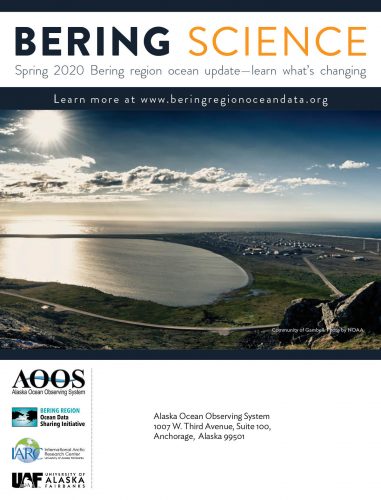IARC releases 'Bering Science' publication
June 22, 2020
 The Bering Sea continues to see dramatic changes in its climate, sea ice conditions
and wildlife, according to a new publication called “Bering Science: Spring 2020 Bering Region Ocean Update.” The report was prepared through a partnership between the Alaska Ocean Observing
System and UAFs International Arctic Research Center.
The Bering Sea continues to see dramatic changes in its climate, sea ice conditions
and wildlife, according to a new publication called “Bering Science: Spring 2020 Bering Region Ocean Update.” The report was prepared through a partnership between the Alaska Ocean Observing
System and UAFs International Arctic Research Center.The team worked with over 20 agency and university scientists from across the region to compile information on a diversity of topics from sea ice and ocean acidification to birds, fish and marine mammals. The focus is on changes observed in 2019 in the northern Bering Sea, with some information about the southern and eastern Bering and the southern Chukchi.
“We tried to give a sample of the changes that scientists and coastal residents are seeing,” said Molly McCammon, AOOS executive director. “We know this publication is not comprehensive, and there is still much we don’t know.”
Some of the most striking changes shared in the report include:
- Warmer than usual ocean temperatures which, for the first time ever, surpassed 46˚F at the seafloor in the southern Bering Sea.
- Despite relatively normal sea ice conditions in early winter, by March the sea ice extent plummeted faster than ever recorded.
- Unusual die-offs of seabirds, ice seals and gray whales in recent years.
- Dramatic changes in distribution of certain fish species.
“The interconnections across the environmental system of the Bering Sea region have been understood by peoples of the region since time immemorial, and the Bering Sea Ocean Data Sharing Initiative is bringing together different features of the Bering Sea environment that have historically been kept apart by western science practice and governmental agency mandates,” said Rick Thoman, Alaska climate specialist with the Alaska Center for Climate Assessment and Policy.
“Rapid environmental changes observed in recent years necessitate collaborative efforts to monitor and report on changes that may affect the health and wellbeing, culture, and livelihoods of coastal communities in Alaska,” said NOAA Fisheries’ Robert Foy, science and research director for the Alaska Fisheries Science Center.
The spring 2020 publication, which was written for a general audience, is intended to be the first of several reports published annually. To be included on future mailing lists, contact Jill Prewitt.
Funding for this publication was provided to AOOS from a national initiative to increase sharing of ocean and coastal data. AOOS is focusing on the Bering Sea region for the initial phase of this project.


